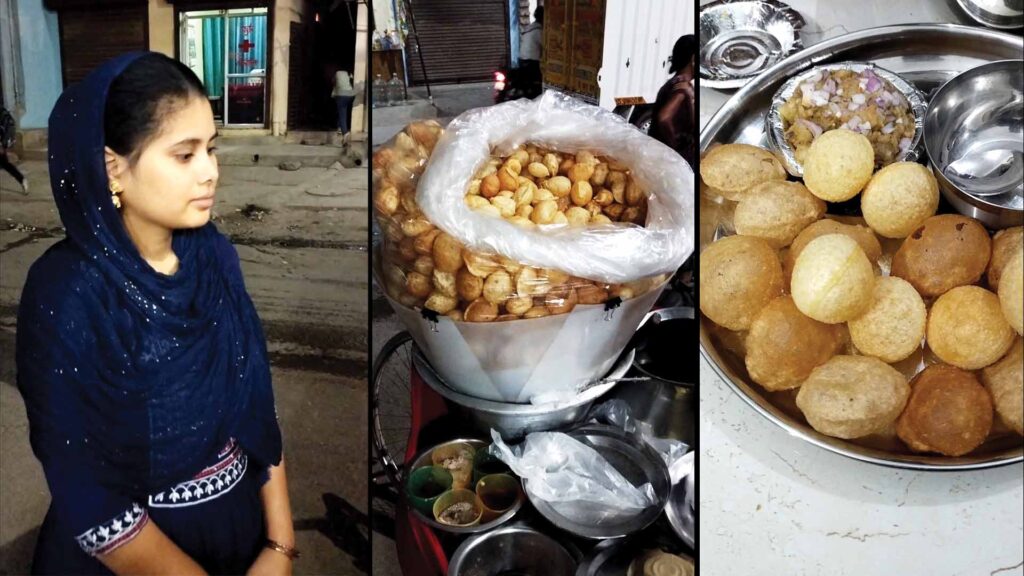
📍 Location: Gurugram, Haryana | Featuring: Tahamina Molla & Asgar Molla
🎥 Watch the video: YouTube Shorts
🍽️ One Dish, Many Cultures
Pani Puri, known by many names like Phuchka, Golgappa, and Gupchup, is more than just a street snack—it’s a cultural identity. Every state in India serves it differently, adding local flavor and personality to this iconic food. In Haryana and Delhi, it’s commonly called Golgappa, served big and crunchy, with bold minty water and sweet tamarind chutney.
In West Bengal, it’s Phuchka, sharp and spicy, made with mashed potatoes, black salt, lemon, and mustard oil. In Mumbai, it’s softer, called Pani Puri, and often stuffed with ragda (white peas curry) and sweet chutney. In Odisha and Jharkhand, you’ll hear the name Gupchup—light, spicy, and often devoured quickly. And in South India, it’s fiery and bold, with green chili water and local masalas.
Though the base is the same—crispy puris filled with spiced stuffing and flavored water—each version tells a different story about the place it comes from.
🎥 Our Experience in Gurugram
This story begins in Gurugram, Haryana, where we—Tahamina Molla and Asgar Molla—found ourselves drawn to a local Pani Puri stall on a warm evening. The vendor’s setup was classic: a steel drum filled with crunchy puris, chilled spiced water in separate bowls, and bowls of mashed potatoes and onions for stuffing.
In our YouTube Shorts video, we are both seen sharing this moment of joy. Tahamina waited excitedly while Asgar captured the behind-the-scenes charm of Indian street food—the laughter of nearby customers, the focused hands of the vendor, the sound of puris cracking as they were filled one by one. Every bite was a burst of flavor and nostalgia.
This wasn’t just content creation—it was us reliving a childhood favorite, reconnecting with the street food culture we both love, and sharing it with our growing digital family.
🙌 Why We Love It
Pani Puri holds a special place in our hearts because it’s simple, accessible, and instantly gratifying. For just a few rupees, you get a full plate of happiness. It doesn’t matter where you’re from—rural Bengal or modern Gurgaon—this snack is for everyone. You don’t even need a table or chair. You just stand, eat, and smile.
It’s also a shared experience. As a couple, we’ve enjoyed many meals together—but there’s something about standing on the street and eating Golgappa from a roadside vendor that feels extra real, raw, and beautiful. It’s not about fine dining—it’s about shared taste, shared memories.
🧂 A Bite of Tradition
Generations have grown up on this snack. From school kids spending pocket money to elders discussing politics over a plate of phuchka, it’s deeply woven into the Indian lifestyle. Vendors become part of the community. Some even remember your preferred spice level or your love for that extra sukha puri at the end.
Each city you visit will offer a new version—and a new memory. That’s what makes this dish so powerful. It travels with you, adapts with you, and welcomes you back each time.
📌 Final Thoughts
Our Gurugram experience was just one chapter in the larger story of Pani Puri culture in India. Whether it’s called Phuchka in Kolkata, Golgappa in Punjab, or Gupchup in Odisha, the soul of the dish remains the same: connection. Between flavors, between people, and between stories.
So, the next time you see a street-side vendor with a stack of puris and a row of flavored waters—stop. Try one. Maybe ten. Bring your friends. Or just go with someone you love. Like we did.
📍 Gurugram, Haryana — Street food, love, and laughter — captured in one unforgettable moment.
🎥 Watch our full experience on YouTube Shorts

Best Fails of The Week 😂 Funniest Fails Compilation 2025 | Viral Funny Videos & Memes
Everyone loves a good laugh, and nothing beats watching the Best Fails of the Week. From hilarious accidents to prank

Best Funny Fails Compilation 2025 😂 Try Not to Laugh Moments from Around the World
Introduction If you’re looking for a good laugh, you’ve come to the right place! Our latest Funny Fails Compilation 2025

Sundarban Crab Farming – From Our Pond to Market | Asgar Molla’s Success Story
Introduction – Life by the Water in the Sundarbans In the heart of the Sundarbans, where mangroves guard the coastline
